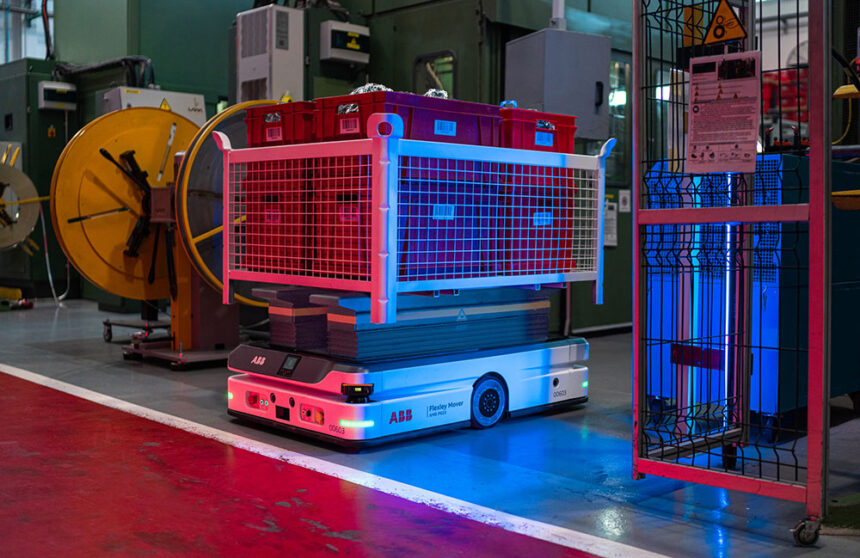ABB Robotics added mobile robots to its portfolio when it acquired ASTI in 2021. | Source: ABB Robotics
Autonomous mobile robots, or AMRs, have grown from a niche technology to an increasingly common part of warehouses in the past 10 years. But now, the AMR industry is facing some challenges.
In July, Interact Analysis lowered its forecast for the AMR industry by $800 million. The market research firm cited a complex mix of geopolitical, economic, and industry-specific challenges.
At the same time, global labor challenges open the door for AMRs to be deployed at an even larger scale in the coming years.
Saurabh Chandra, founder and CEO of Ati Motors; Florian Pestoni, co-founder and CEO of InOrbit; and Vaithy Kandasamy, global AMR portfolio manager at ABB Robotics, shared insights with The Robot Report on where the market is headed.
End users face similar challenges around the world
Around the world, and across industries, it’s becoming more and more difficult to find people to do mundane, repetitive tasks. With headquarters in the U.S. and India, Ati Motors has done work in Mexico and across Asia, giving Chandra a truly global perspective. In addition, the company does most of its work in manufacturing, a relatively new industry for AMRs.
“Manufacturing has globalized well over the past 50 to 100 years, and there’s a lot of best practice sharing among manufacturers. Most of the production environments are very similar across the world,” he said. “Another thing I expected to be different was the hunger for this kind of automation. Surprisingly, it’s the same everywhere, irrespective of labor costs.”
No matter the country or cost of labor, it’s difficult to find people for manufacturing roles. “It’s a global phenomenon that the younger generation doesn’t want to do eight hours of mindless work,” said Chandra. “I think repeating the same motion 100 times is not something humans were designed to do.”
InOrbit works closely with end users in a range of industries to help them optimize their operations with its software, and Pestoni has seen a similar trend.
“A lot of the end users we talk to are facing similar challenges, regardless of what industry they’re in,” he observed. “A lot of them have labor shortage challenges, especially in the kind of tasks that are maybe more repetitive and less exciting. It’s harder to attract people to those kinds of jobs.”
As more countries are seeing shrinking and aging workforces, and immigration slows, Pestoni said this problem isn’t going away anytime soon.
“Before, [users] might have only used robots in essential tasks that were super-repetitive and extremely well-defined,” he said. “These are the classic applications of industrial robots, like in automotive. Now, they’re thinking they need that [automation] for many more workflows.”
AI presents new AMR opportunities
Technologies that make AMRs easier to deploy, service, and work with will be crucial for large-scale deployments. This is why Ati Motors and ABB are working to integrate the latest AI technologies into their robots.
“LLMs [large language models] and generative AI are revolutionizing human-robot interaction with no need for specialized programs,” explained Kandasamy. “Robot systems can interact with humans using simple spoken instructions or even by recognizing a hand gesture. The system can learn continuously by itself to optimize the fleet performance and productivity.”
“Unpredictable or complex environments can be better solved with enhanced decision-making by AI, especially LLMs,” he added. “It can also enable smarter decisions such as fleet/mission management, fault diagnostics, predictive maintenance, etc. This democratizes access to automation, removing the need for advanced technical skills and accelerating adoption across new sectors.”
But generative AI isn’t just helpful for the human interaction side of things. Physical AI is also becoming an important topic in robotics.
“AI is enhancing everything from AMRs’ ability to pick, place, and handle larger payloads, as well as their ability to map and navigate through dynamic environments,” Kandasamy said. “AI is giving robots unprecedented levels of speed, accuracy, and payload carrying ability, enabling them to take on more tasks in settings like flexible factories, warehouses, logistics centers, and laboratories.”
“AMRs equipped with ABB’s new AI-powered visual SLAM technology have advanced mapping and navigation skills, granting new levels of autonomy, while greatly reducing the infrastructure needed by previous generations of guided robots,” he asserted. “AI-enabled functionalities such as object recognition, stacking, free navigation, etc., can further enhance flexibility and productivity. This paves the way for a shift from linear production lines to dynamic networks, creating significant efficiencies and taking on more dull, dirty, and dangerous tasks to enable workers to take up more rewarding jobs.”
Editor’s note: RoboBusiness 2025, which will be on Oct. 15 and 16 in Santa Clara, Calif., will include the Physical AI Forum, a new session track dedicated to physical AI. Registration is now open.
Uncertainty around tariffs causes concern
Rising U.S. and global tariffs were one of the factors that Interact Analysis cited in downgrading its mobile robot market forecast. The firm’s Global Economic Policy Uncertainty (GEPU) Index hit an all-time high of 430 in January 2025. This level of uncertainty exceeded those of the 2008 financial crisis and the COVID-19 pandemic.
In the meantime, many companies are adopting a “wait-and-see” approach, delaying strategic investments in warehouse automation and infrastructure. This is a trend Ati Motors’ Chandra has seen firsthand.
“It’s not so much the tariffs, but the uncertainty, which is getting to people,” he said. “That sometimes becomes a factor in the intent getting delayed. People say, ‘Why don’t we let this settle and look at it next quarter?’”
Chandra said he believes that once tariff levels are finalized, the AMR market will improve. “I think we are getting to a level where the uncertainty, hopefully, will reduce. Although the tariffs are high, they are uniformly high for almost everybody,” he said.
ABB is taking a longer-term look at the issue.
“If there is a higher-tariff situation for a prolonged time, global AMR players may consider a local manufacturing footprint for the U.S. market,” Kandasamy said. “There can still be cost challenges due to some key imported components. If the overall AMR solution cost increases, it needs to be compensated for by faster commissioning to maintain the attractive ROI [return-on-investment] levels. Overall, the U.S. AMR market is sizable as well as important for global players.”
AMR tech matures as new markets beckon
The AMR market is maturing, and the robotics industry has solved many of its core technology problems, according to Chandra. It is now moving on to solving “second-tier” issues.
“Change management and adoption in the large manufacturing giants, and doing that last inch of automation,” he said. “That becomes tricky, because it becomes custom. This is difficult to productize.”
“We’re really thinking, ‘Can we build smallish, peripheral products which can be dragged and dropped into various deployments, rather than you build them from scratch everywhere?’” Chandra continued.
ABB is looking to new industries for deployment opportunities. Kandasamy highlighted automotive, manufacturing, logistics, e-commerce, and warehousing as more established markets.
“More adaptation can be expected in electronics; inventory management; and service sectors such as hotels, restaurants, and healthcare,” Kandasamy said. “New AMR applications in clean room, cold room, hygiene, and hazardous environments require specific design considerations and additional certifications. Promising clean-room applications, which require contamination-free automation, include semiconductor, battery cell production, and medical laboratories.”
Despite challenges in the industry, InOrbit’s Pestoni said interest in AMRs is up. “I think what has changed, especially recently, [is] there’s more appetite to adopt and to adopt faster. It’s in more places, so I think it’s a really exciting time to be in robotics,” he said.



























